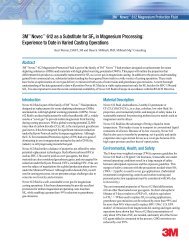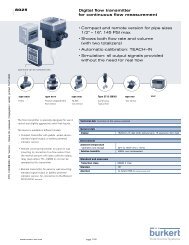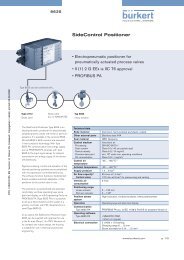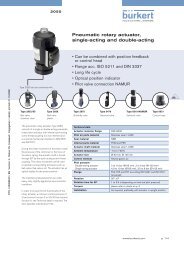Solenoid valves - Bürkert Fluid Control Systems
Solenoid valves - Bürkert Fluid Control Systems
Solenoid valves - Bürkert Fluid Control Systems
Create successful ePaper yourself
Turn your PDF publications into a flip-book with our unique Google optimized e-Paper software.
Copper<br />
shading<br />
ring<br />
Air gap<br />
Stopper<br />
1.3.2. <strong>Solenoid</strong> coils for alternating<br />
current<br />
On AC coils, the current is determined<br />
not only by the ohmic resistance of the<br />
windings, but also by the inductive<br />
resistance (reactance). The inductive<br />
resistance is significantly influenced<br />
by the position of the solenoid core. If<br />
the solenoid core has dropped out,<br />
the inductive resistance is lower and<br />
the coil current is higher. The current<br />
is thus higher in the pick-up phase than<br />
the coil current in the holding phase.<br />
As compared to a DC coil, coil resistance<br />
is far lower with the same voltage<br />
value being applied. Consequently, a<br />
coil should never be operated without<br />
a solenoid core when operating with<br />
AC voltage. Otherwise, there is a risk<br />
of the coil overheating and burning<br />
out after a few minutes.<br />
s<br />
Stationary guide<br />
Functional principle of an AC solenoid<br />
The inductive resistance is also dependent<br />
on the mains frequency. This is,<br />
for example, higher at 60 Hz than at<br />
50 Hz. If a solenoid coil designed for<br />
50 Hz is operated with 60 Hz, the magnetic<br />
force of attraction on the core will<br />
be lower. The loss of force is 10-30%<br />
depending on design and size. With<br />
direct-acting solenoid <strong>valves</strong>, this<br />
means restrictions in the pressure<br />
range for practical applications.<br />
If a coil designed for 60 Hz is operated<br />
with 50 Hz, this results in an increased<br />
power consumption with a higher coil<br />
temperature. The coil could be damaged<br />
under such extreme operating conditions.<br />
Winding<br />
Moving core/<br />
Armature<br />
One other special factor is the need<br />
for an electrically conductive ring<br />
(shading ring) in the stopper of the<br />
solenoid coil. If an AC solenoid was to<br />
be operated without the shading ring,<br />
the armature itself would constantly<br />
oscillate at the oscillation frequency of<br />
2 x mains frequency (50 Hz or 60 Hz),<br />
even with very slight forces of the return<br />
spring when energized since, with<br />
each zero crossover of the sinusoidal<br />
mains voltage, the holding force which<br />
represents a sinusoidal-quadratic curve<br />
drops practically to zero twice per period.<br />
Since this means that the force<br />
of the return spring increases above<br />
10/11








